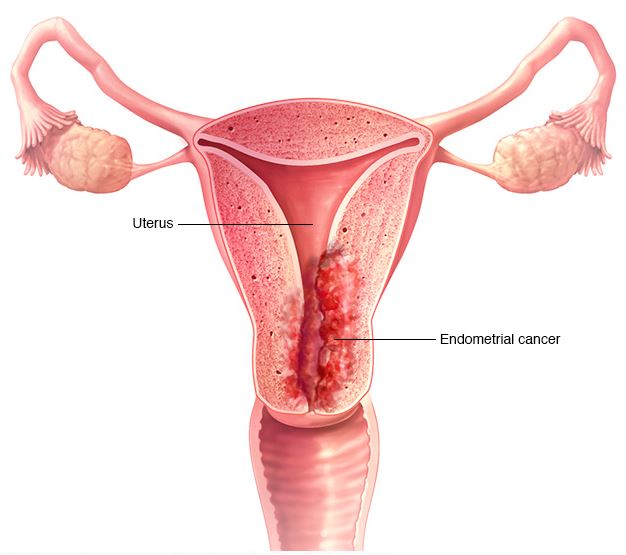Endometrial or Womb or Uterus Cancer starts in the endometrium or Uterus or Womb, the inner lining of the uterus (womb).
 About the Uterus (Womb) and Endometrium
About the Uterus (Womb) and Endometrium
The uterus is a hollow organ, which is normally about the size and shape of a medium-sized pear. It is the part where a fetus grows and develops when a woman is pregnant. The uterus (Womb) has two main parts.
- The Cervix is the lower end of the uterus that extends into the vagina.
- The upper part of the uterus is called the body or the corpus.
When people discuss on cancer of the uterus, they generally mean the body and not the cervix. Although the Cervix is technically a part of the uterus.
The body of the uterus has two main layers.
Endometrium – The inner layer or lining.
Myometrium – The outer layer of muscle.
This thick layer of muscle pushes the baby out at the time of delivery. Serosa tissue coated the uterus from outside.
During a woman’s menstrual cycle, hormones cause the endometrium to change. During the early part of the cycle, before the ovaries release an egg (ovulation), the ovaries produce hormones called estrogens. If pregnancy occurs, estrogen causes the endometrium to thicken so that it could nourish an embryo. If pregnancy is not there, the production of estrogen occurs in a lower amount, and the hormone called progesterone made after ovulation occurs in large amount. It prepares the innermost layer of the lining to shed. By the end of the cycle, the endometrial lining is shed from the uterus and becomes the menstrual flow (period). This cycle repeats until the women go through menopause (change of life).
Uterus and Endometrium Cancers
The two main types of cancer of the uterus are:
- Uterine sarcomas, start in the supporting connective tissue of the uterus or the muscle layer (myometrium). These include endometrial stromal sarcomas and uterine leiomyosarcomas. These cancers discussed in detail in Uterine Sarcomas.
- Endometrial carcinomas, start in the cells of the inner lining of the uterus (the endometrium). Nearly all cancers of the uterus are this type. These cancers are the focus of the remainder of this information.
Endometrial carcinomas divided into different types based on how the cells look under the microscope (histologic types).
Types
- Adenocarcinoma, (most endometrial cancers are adenocarcinomas)
- Carcinosarcoma (discussed more below)
- Squamous cell carcinoma
- Undifferentiated carcinoma
- Small cell carcinoma
- Transitional Carcinoma
Endometrioid cancer is the most common type of adenocarcinoma. Endometrioid cancer basically made up of cells in glands that look much like the normal uterine lining (endometrium). Some of these cancers contain squamous cells (squamous cells are flat, thin cells that can be found on the outer surface of the cervix), as well as glandular cells. Cancer with both types of cells usually called an adenocarcinoma with squamous differentiation. If under the microscope, the glandular cells look cancerous, but the squamous cells do not, the tumor then called an adenoacanthoma. If both the squamous cells and the glandular cells look malignant (cancerous), these tumors then called adenosquamous (or mixed cell) carcinomas. There are other variants (or sub-types) of endometrioid cancers, such as secretory carcinoma, ciliated carcinoma, and villa glandular adenocarcinoma.
Clear-cell carcinoma, mucinous adenocarcinoma, and papillary serous adenocarcinoma are less common types of endometrial adenocarcinomas. These types are considered to be more dangerous than most endometrial cancers. They often grow rapidly and then spread outside the uterus during diagnosis.
Uterine carcinosarcoma (CS) starts in the endometrium and has features of both endometrial carcinoma and sarcoma. Earlier, CS was considered a kind of uterine sarcoma, but now doctors believe that CS is a carcinoma. This one is abnormal and thus no longer looks like the cells it came from (poorly differentiated).
Uterine CS considered as a type 2 endometrial carcinoma. CS tumors further called as malignant mixed mesodermal tumors or Malignant Mixed Mullerian Tumors (MMMTs). They make up about 4% of uterine cancers.
Signs and symptoms of Uterus or Endometrial Cancer
There are a few symptoms that may point to endometrial cancer, but some are more common as this cancer becomes advanced.





